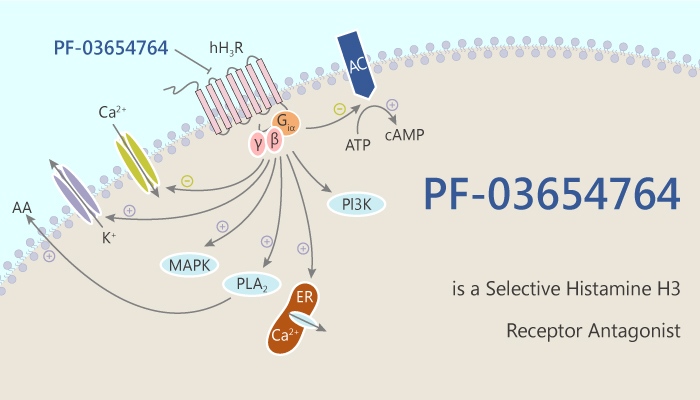The symptoms of Allergic rhinitis are rhinorrhea, sneezing, nasal pruritus, congestion, and aggravation of comorbid asthma. Histamine can interact with 4 receptor subtypes, including H1, H2, H3, and H4. Many antihistamine agents affecting the H1 receptor can be used for acute relief of allergic rhinitis. These agents effectively reduce sneezing and rhinorrhea, however, they have limited-effectiveness against congestion.
As a result, traditional antihistamines always combine with sympathomimetic decongestants such as pseudoephedrine for allergic rhinitis treatment. But, this combination is not acceptable for those with cardiovascular problems. The development of H3 receptor antagonists as decongestants may show a bright future for available treatments.
In this article, we will introduce an orally active, selective histamine H3 receptor antagonist, PF-03654764.

PF-03654764 is a histamine H3 receptor antagonist with Ki values of 1.2 nM and 7.9 nM for human H3 and rat H3 in a whole-cell assay, respectively. It has >1000-fold selectivity for the H3 receptor over the other histamine receptor subtypes.
Firstly, in vitro, PF-03654764 has pKi values of 8.98 and 8.10 for human H3 and rat H3 in a whole-cell assay, respectively. It also exhibits pKi values of 8.84, 7.73, and Ki values of 1.4 nM and 19 nM for human H3 and rat H3 in HEK-293 cells, respectively.
Next, PF-03654764 has good PK profiles in rats and dogs. In Sprague-Dawley rats, it has a Cmax of 8057 ng/mL and an AUC0-24 of 67400 ng•h/mL. Additionally, PF-03654764 has a Cmax of 6302 ng/mL and an AUC0-24 of 18175 ng•h/mL in beagle dogs.
Lastly, Recently, Stokes et al. use acoustic rhinometry to measure changes in minimum nasal cross-sectional area and nasal volume after treatment. As a result, they find that PF-03654746 combines with Fexofenadine significantly reduces subjective congestion scores. Since the primary objective is to see the efficacy of congestion, the non-significant response to H3 antagonism to measured-vascular congestion in humans is important.
In conclusion, PF-03654764, as an orally active, selective histamine H3 receptor antagonist, it has the potential for allergic rhinitis research.
Reference:
[1]. Travis T Wager, et al. J Med Chem. 2011 Nov 10;54(21):7602-20.
[2]. Michelle L North, et al. Allergy Asthma Clin Immunol. 2014 Jul 3;10(1):33.